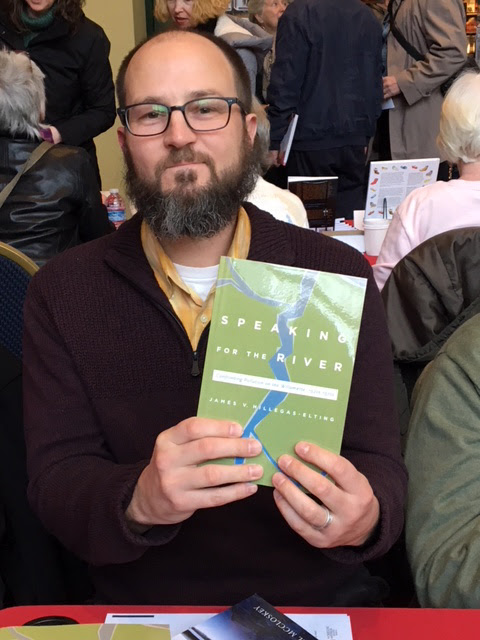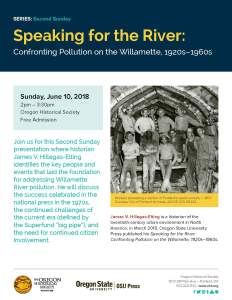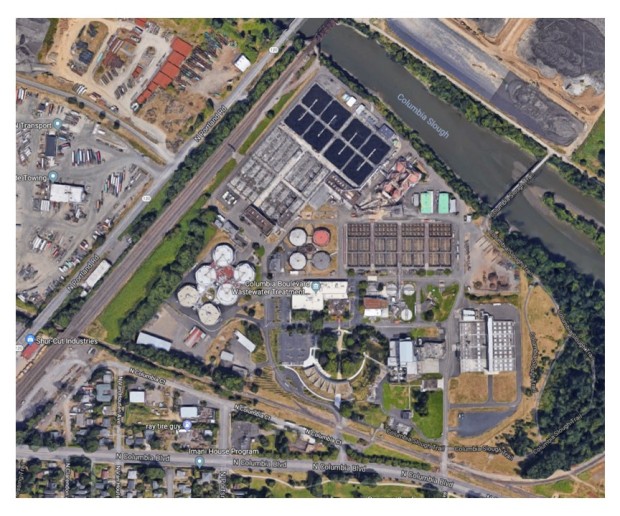Brazier on Speaking for the River
Posted by jvhillegas-elting in Book News on October 22, 2019
The Pacific Northwest Quarterly recently published a book review [1] from Hayley Brazier. As I wrote about in response to my first book review, I welcome this feedback but am also nervous, every time!
Brazier writes that whereas the book’s “detailed regional focus will be of interest to readers associated with Portland and the Pacific Northwest,” it “will also attract a broader field of historians researching urban development, pollution, and sanitation.” This is heartening, because I really endeavored to create a work that was very much grounded in a specific place, and time, and group of people, but that had broader regional, national, and even international resonance.
Brazier then commends my “use of geographic information system (GIS) technology to develop effective maps, revealing the author’s skills in both traditional archival research and the digital humanities.” I definitely appreciate this feedback. I went through many iterations of the map that appeared on p. 67, in particular, in which I georeferenced September 1934 water quality data on a map of Portland Harbor from the 1930s (which I digitized), to help illustrate how degraded water quality was. From my research through 2016, this was the first time I’d seen anything like this kind of data-driven cartographic representation in a work of environmental history. I hope to have the opportunity to do more of this in the future!
There are two critiques Brazier raises that I’d like to address. Read the rest of this entry »
Dirty Water
Posted by jvhillegas-elting in Book News, Events on March 10, 2019
I appreciated the opportunity to speak with Willamette Week‘s James Helmsworth prior to my talk at Powell’s Books. Willamette Week published James’ interview with me in their February 20, 2019, issue (45/17).[1]
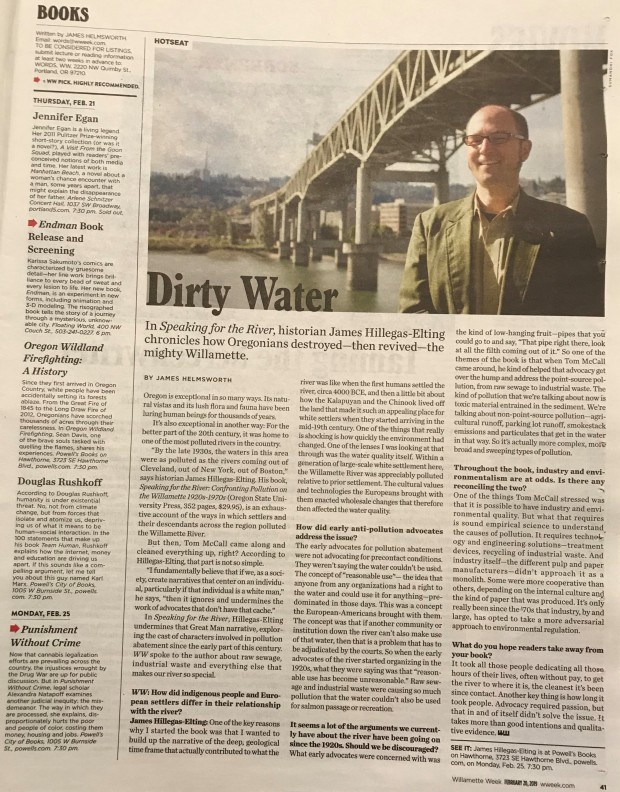
One key point Helmsworth extracted from the interview was that it took many people many decades–from the 1920s into the 1970s–to address egregious water pollution (which, in those decades, was primarily caused by municipal sewage from the City of Portland and pulp & paper industry wastes). In highlighting the significant efforts of these many people and organizations, I wanted to de-center the role that Tom McCall played in cleanup efforts. This is not to discount McCall’s important role in Oregon environmental and civic history, but to make the narrative more accurate and more complex.[2] A result of doing so is to provide tangible, real-world evidence of the importance of an engaged citizenry in the democratic process. More often than not, positive social and environmental change requires multitudes, and concocting simplified narratives centered on an individual is both inaccurate and demeaning to the many others who contributed (as I’ve written about elsewhere).
—–
[1] As of March 2019, I haven’t been able to find Helmsworth’s article online, so I’m unable to link directly to it. Willamette Week did, however, provide an electronic link to my talk as part of their weekly “Book Picks.”
[2] We historians take it as a fundamental purpose of our discipline to uncover and present evidence that makes over-simplified narratives more complex–and, thereby, more accurate!
Larson on Speaking for the River
Posted by jvhillegas-elting in Book News on February 13, 2019
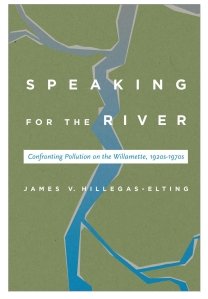 I’ve just read Derek R. Larson‘s review of my book, to be published in the April 2019 issue of Environmental History. It’s the first academic review of my first book. I was nervous. I knew this would come. As an editorial fellow and academic peer reviewer, I recognized this would happen. Concurrently I welcome the broader response of my academic peers, while also fearing it.
I’ve just read Derek R. Larson‘s review of my book, to be published in the April 2019 issue of Environmental History. It’s the first academic review of my first book. I was nervous. I knew this would come. As an editorial fellow and academic peer reviewer, I recognized this would happen. Concurrently I welcome the broader response of my academic peers, while also fearing it.
Larson makes some observations that I had truly hoped readers would take from this work. These include:
- My struggle to weave “science, policy, and a host of individual actors into a narrative tapestry, while keeping the ultimate focus on the health of the river itself.”
- My goal of “emphasizing scientific and policy sources” to keep “the Willamette at the center of every chapter.”
- My humble intention to offer “the most comprehensive examination to date of the Willamette River’s fabled near death and rebirth, emphasizing the ongoing struggle to balance water quality against competing uses in a period of rapid population growth and economic expansion.”
Larson also observes that “The human actors in the story come through in less detail; one major exception is David B. Charlton, a scientist and water quality advocate, who appears at the center of the action from the 1930s into the 1970s.” I don’t disagree. I tried to give the key figures at least some brief biographical background, without making the book overly complex and verbose. There certainly are more people involved in this story who should get more credit. I look forward to doing this myself when possible, and reading others’ works in this area–particularly for the period from the 1970s forward, and involving peoples of color. On this matter, the key takeaways I want to leave with every reader, however, are three-fold. First, it took more than Tom McCall to resolve the egregious water pollution that persisted into the 1960s; second, it has taken even more effort from more people to address Willamette River water pollution since the 1970s; finally, the current generation of advocates may find things to learn from and build upon in the history of their progenitors.
“The Willamette River and its polluted past”
Posted by jvhillegas-elting in Beyond the Dusty Archives, Book News, Events on February 10, 2019
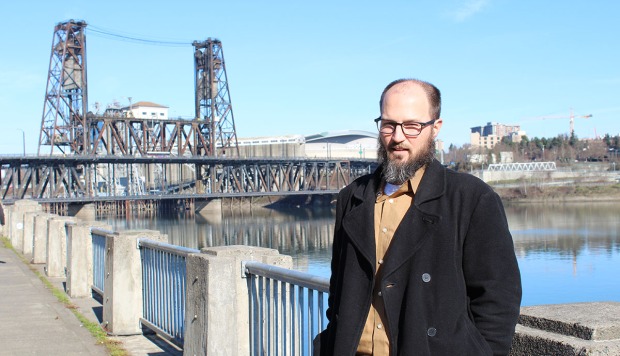
I really appreciated the opportunity to speak with Emily Green of Street Roots a few days ago, as well as the article she wrote about Speaking for the River and my upcoming talk at Powell’s Books.
She captures my sentiments in writing “I think Tom McCall gets over-elevated. He came toward the end of the low-hanging-fruit era, which is the era of addressing specific point-source pollution discharges that were focused much more on dissolved oxygen and bacteria.” As I wrote in a post for the Oregon State University Press blog, McCall represents “Not the End, but the End of the Beginning.”
I look forward to comments and questions at my Powell’s talk on February 25, 2019!
Book talk at Powell’s Books, Feb. 25 2019
Posted by jvhillegas-elting in Beyond the Dusty Archives, Book News, Events on February 5, 2019
I’ll be giving a book talk at Powell’s Books, Hawthorne location, the evening of February 25. Come on by for some wonky-yet-engaging discussion of the history of water pollution abatement efforts within a major watershed in the western U.S.
Contribute some challenging questions and get a copy of the book signed as well!
See http://www.powells.com/calendar for details.
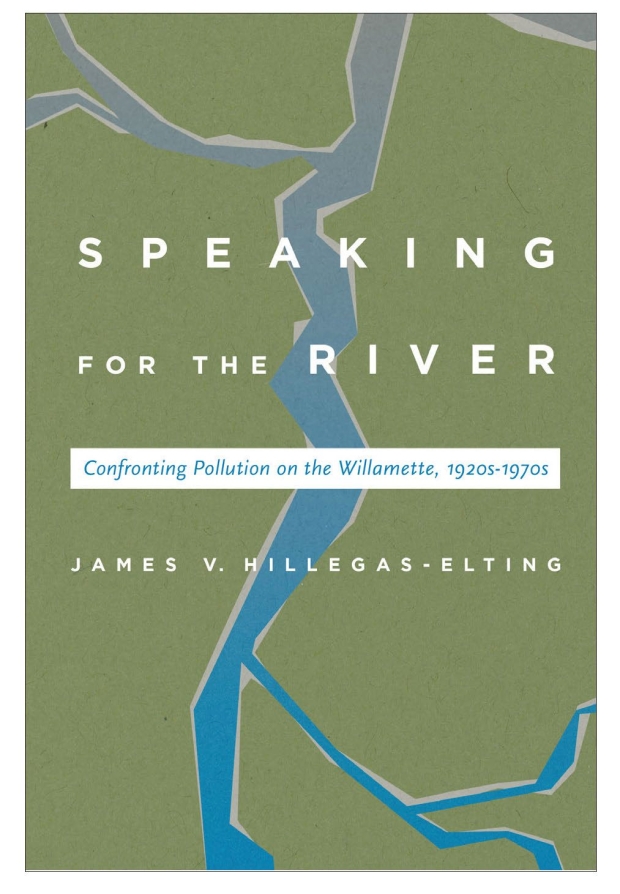
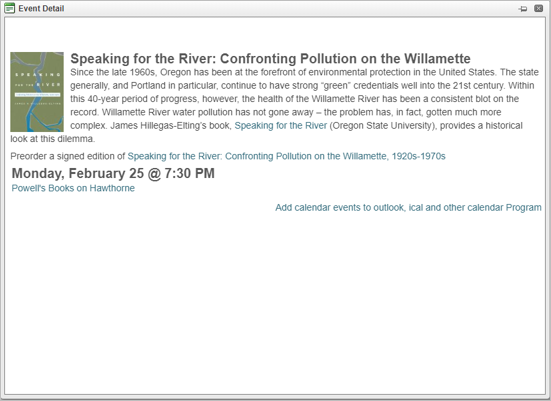
Choice Outstanding Academic Title, Oct. 2018
Posted by jvhillegas-elting in Book News on December 11, 2018
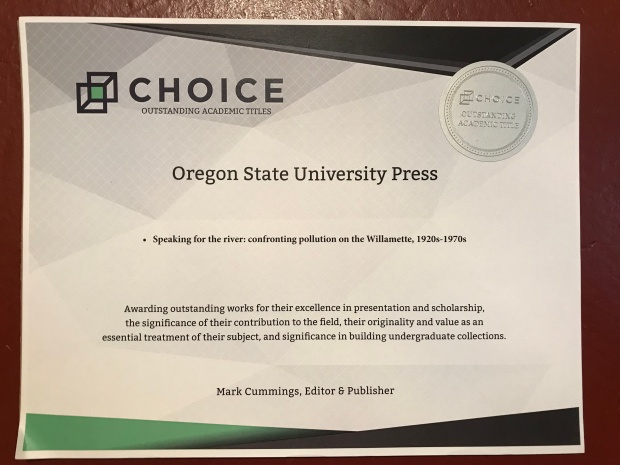
Editors at Choice–“a publishing unit at the Association of College & Research Libraries, a division of the American Library Association”–named Speaking for the River an “Outstanding Academic Title” in October 2018. The Head of Oberlin College’s Science Library Alison Ricker writes that the book is “exceptionally readable, compelling, and highly relevant to any situation in which citizen groups and state and federal government bodies grapple with polluters.” This is extremely gratifying to read, because this was foremost among my intentions in writing the book, but unless and until I receive feedback from readers I cannot know that I’ve achieved my goal!
Ricker further concludes that “the book—with its extensive bibliography, bibliographic essay, 50 illustrations, and detailed index—will inform policy makers and environmentalists alike.” This was also a goal. I wanted to produce a work that could be appreciated not only by other academics, but by people and citizen groups working on current environmental issues.
Holiday Cheer event at the Oregon Historical Society, Dec. 2018
Posted by jvhillegas-elting in Beyond the Dusty Archives, Book News, Events on December 5, 2018
I had a great time with 90+ other Oregon authors at the Oregon Historical Society’s 51st Annual Holiday Cheer event!
I sat next to (and got to meet for the first time) Susan Stoner, Ron Lovell, and Michael McCloskey. I also got to chat with colleagues who’ve recently published books: Val Ballestrem, Heather Mayer, Teresa Bergen, Katy Barber, Richard Etulain, and William Willingham.
Many thanks to the Oregon Historical Society for organizing this event and inviting me, and to the OSU Press team for coordinating the logistics. All I had to do was show up, talk about water pollution, and strike cheeky poses–such as the one below!
Speaking for the River talk at the Oregon Historical Society, June 10, 2018
Posted by jvhillegas-elting in Beyond the Dusty Archives, Events on June 12, 2018

James V. Hillegas-Elting presenting at the Oregon Historical Society, June 10, 2018 (Kristina Hillegas-Kieffer, photographer).
Many thanks to everyone who attended my June 10 talk at the Oregon Historical Society. I appreciated the opportunity to discuss some of the key themes of the book: 1) environmental changes within the watershed which led to 2) a group of abatement advocates organizing to change predominant ideas about how society ought to interact with the watershed, which then contributed to 3) practical legal, policy, and administrative changes based on these new ideas, which then 4) had to be translated into material and physical changes to address point-source pollution.
I look forward to future events and conversations!
When the polluted Willamette River caught fire
Posted by jvhillegas-elting in Portland Metro Area on April 18, 2018
Another thing I’ve heard said recently (and over the years) is that the Willamette River was so polluted through Portland Harbor that it caught fire. Like the Cuyahoga River had done. Wow–that’s spectacular, and tragic!
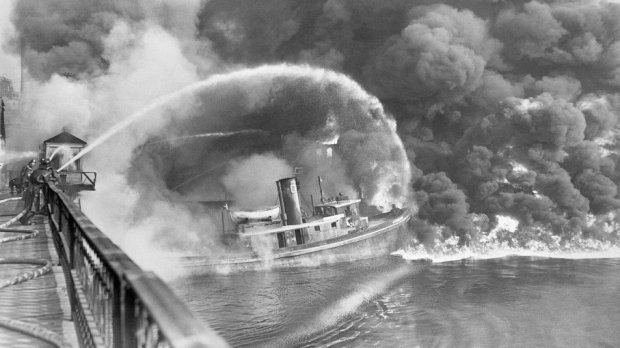
Cuyahoga River fire, 1969. (https://www.missedinhistory.com/podcasts/cuyahoga-river-fires.htm)
It didn’t happen.
I state that with a very high level of confidence, having read at least 700 newspaper articles between 1906 and 1996 and conducted extensive archival research into the records of the State Game Commission, State Fish Commission, State Board of Health, Oregon State Sanitary Authority, Oregon Department of Environmental Quality, and City of Portland. With this knowledge, the assertion that the Willamette caught fire seemed apochryphal. Out of curiosity, I then searched the Internet for blog posts or other sources for the urban myth. While I didn’t find any blog posts, I did find quite a few news reports of warehouse, dock, or houseboat fires over the years, but nothing about any grand conflagrations of the kind that occurred on the Cuyahoga.
So, if you ever hear anyone make this claim, you now know it’s not true!
On the Siting of Portland’s Wastewater Treatment Plant: Environmental Racism, or Not?
Posted by jvhillegas-elting in Environmental Racism, Portland Metro Area, Sewers & Sewage on March 30, 2018
I heard a statement recently suggesting that one of the reasons the City of Portland built its wastewater treatment plant where it did–at the far north of the city–was that this was where people of color lived. The decision was, therefore, an example of environmental racism, whereby white civic leaders burdened communities of color with urban infrastructure that wouldn’t have been tolerated in white, affluent neighborhoods.
Having read sanitary engineer Dr. Abel Wolman’s 1939 report on the Portland’s sewer system, I knew first-hand the engineering logic behind this decision. I didn’t know enough about the area in which the treatment plant was built to have a perspective on the question of whether or not its siting was an example of environmental racism. With help from the experts at the City of Portland Archives, it was time for some research!
